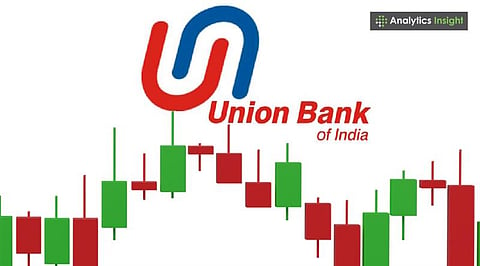

Union Bank share price fell 4.06% to ₹144.15 after a 6% intraday low triggered by weak Q1FY26 performance.
The bank reported a drop in both advances and deposits over the quarter, but strong growth in the retail lending segment.
Analysts remain cautiously optimistic, with 62% recommending a ‘Buy’ rating amid a low P/E of 6.10 and strategic capital plans.
Union Bank of India’s share price slipped over 4.06% as of 11.59 AM to ₹144.15 on July 9, 2025. The decline follows a 6% intraday crash to ₹141.54 earlier in the session. Investors are reacting to the public sector bank’s weak Q1FY26 results. The update shows a sequential dip in both loan advances and deposits.
Union Bank reported a 0.85% quarter-on-quarter (QoQ) decline in global gross advances, which now stand at ₹9.74 lakh crore. Domestic advances also shrank 0.83% QoQ to ₹9.38 lakh crore. On the contrary, the year-on-year (YoY) growth rose to 6.83% from 6.75%, respectively. However, the short-term contraction has shaken investor confidence.
Deposits fell even more sharply, with domestic ones slipping 2.54% QoQ to ₹12.39 lakh crore. Domestic CASA (Current Account Savings Account) deposits dropped by 5.43% QoQ to ₹4.03 lakh crore. Overall, the bank’s total business stood at ₹22.14 lakh crore, up 5.01% YoY.
Despite these setbacks, there were signs of strength in the RAM (Retail, Agriculture, and MSME) segment. The domestic RAM portfolio rose 2.5% QoQ and 10.31% YoY to ₹5.45 lakh crore. Retail advances were especially strong, growing 5.63% sequentially and an impressive 25.60% YoY to ₹2.29 lakh crore. This shows a shift in strategy toward more retail-focused lending to cushion against institutional slowdown.
Also Read: Stock Market Today: Kotak Bank (+3.4%), Infosys Propel July 8 Rally; Sensex 83,712, Titan Dips 6% and Stocks to Watch for July 9
Union Bank share price opened at ₹147.85 and hit a day’s low of ₹141.54. As of 11:55 AM, it was trading at ₹144.15. The volume traded stood at over 2.1 crore shares, with a value of ₹3,040.8 crore. The Volume-Weighted Average Price (VWAP) was ₹143.80, showing consolidation near intraday lows. The bank’s market cap is currently ₹1.10 lakh crore.
The following Union Bank share price chart shows a loss of 3.83% as of 12.26 PM:
Technical indicators paint a neutral to bearish picture. The Relative Strength Index (RSI) remains below the midpoint, indicating weak momentum. According to Bonanza's analyst Drumil Vithlani, the stock is consolidating between ₹159-₹138. Thus, suggesting a sideways trend unless a clear breakout occurs. Experts advise keeping a stop loss below ₹138.
Union Bank’s board recently approved raising ₹6,000 crore via equity and bonds. This includes:
₹3,000 crore through equity issuance (public issue, rights, QIP).
₹2,000 crore via Additional Tier-1 (AT-1) bonds.
₹1,000 crore via Tier-2 bonds, including foreign currency instruments.
This capital will be used to fund future growth and strengthen balance sheets, especially as the bank expands in the retail and MSME space.
Union Bank stock trades at a P/E ratio of 6.10, below the sector average of 8.93. It has a P/B ratio of 1.03, which is on the higher side historically. The stock offers a dividend yield of 2.50% and a book value per share of ₹140.91.
Analyst sentiment remains cautiously optimistic. The majority (62%) recommend a ‘Buy’ rating. Meanwhile, others (30%) are divided equally between ‘Underperform’ and ‘Hold’ ratings. Only a slight percentage, approximately 8% analysts gave the stock an ‘Outperform’ rating today.
Union Bank's share price decline today shows investor concerns over its Q1 update, particularly the sequential fall in deposits and loan growth. However, strong retail lending momentum, ongoing capital raising plans, and a relatively cheap valuation may offer long-term potential. For now, the stock remains in a consolidation phase, and traders should await a breakout before taking fresh positions.
Also Read: Elon Musk’s Net Worth Drops by $15.3 Billion After Tesla Stock Crashes
1. What is the share price of Union Bank in 2025?
Union Bank of India's share price today stands at ₹144.15, reflecting a 4.06% decline from the previous close. The intraday low touched ₹141.54 after the bank posted a Q1FY26 business update showing a quarter-on-quarter dip in loan and deposit growth. Despite the short-term weakness, the stock has gained over 40% from its 52-week low of ₹100.81.
2. How many shares are outstanding in Union Bank?
Union Bank of India has a market capitalization of approximately ₹1.10 lakh crore. Given its current share price of ₹144.15, this translates to roughly 76.33 crore outstanding shares. This figure may vary slightly due to changes from buybacks, ESOP allotments, or fresh equity issuance. For the most accurate number, refer to the bank’s latest investor filings or quarterly disclosures.
3. What is the share price target for Union Bank shares today?
Analyst targets for Union Bank of India today vary based on technical levels. Immediate resistance lies at ₹152.82, followed by ₹155.38 and ₹157.34. Support levels are pegged at ₹148.30 and ₹146.34, with strong downside protection around ₹138. Technical analysts currently suggest a sideways trend unless the price breaks out above ₹159 or below ₹138 decisively.
4. Why did Union Bank share price drop today?
Union Bank shares fell over 4% on July 9, 2025, after the bank’s Q1FY26 business update reported a 0.85% QoQ decline in gross advances and a 2.54% QoQ drop in deposits. Domestic CASA also fell 5.43% during the quarter. Despite strong growth in retail lending, the weakness in deposit growth triggered investor concern. Thus, leading to the price correction.
5. Is Union Bank stock a good investment right now?
Union Bank has shown consistent year-on-year improvements in its retail and MSME lending segments. Its TTM PE is 6.10, below the sector average of 8.93, and the stock offers a 2.5% dividend yield. However, the recent decline in deposits and gross advances suggests near-term caution. Analysts are mostly positive, with 62% rating it a ‘Buy’ and 15% ‘Hold’, indicating long-term potential once key metrics stabilize.
